How gameplay can be narrative: a lesson from Riven

[~1800 words]
Riven (the sequel to Myst) has a game design philosophy in which the gameplay and narrative are the same thing. So, I decided to look at one clever example of this.
Waxing about Myst:
Myst was a great game and perhaps one of the first “art” games (I could probably write a whole blog post about this alone). “Walking simulators” like the Stanley Parable, Dear Esther, and Gone Home owe their existence to Myst paving the path over a decade earlier. Its artistry has been overlooked by most people because at the time of release (1993) no one gave a damn about games as an art form. And then Doom came out and the only thing people cared about were those types of games.
One of the consequences of Myst being passed off as a novelty of its time is that its sequel, Riven, never got the intellectual and academic scrutiny it deserved.
Which is a shame, because Riven is, in many ways, a massively superior game to Myst, and from a design perspective it is a completely different game altogether.
All of Myst’s puzzles were standalone, surreal, abstract brain teasers, and if you removed Myst’s story then 99% of the puzzles would remain unchanged. But Riven intertwines its narrative story and its gameplay in very elegant ways (and in my opinion its storytelling techniques are better than Half-life, which was released a year later). That’s not to say that you need to know the story to solve the puzzles, but if you were to change Riven’s story or characters then you would also have to change Riven’s puzzles simultaneously.
I don’t know if the game community is still discussing how to merge narrative and gameplay, or how to keep gameplay and narrative from working against each other. I don’t read any gaming sites anymore, but I remember that this was a discussion going on back in the day. And what disappointed me was that Riven provided some perfect answers to the questions the community was asking, but no one was bringing it up.
The Shift from Myst to Riven
Riven could have ended up very similar to Myst, and some of the early designs for puzzles followed Myst’s abstract, detached-from-the-world template. However, even towards the end of Myst’s development a shift was taking place in terms of the team’s design philosophy. They were moving from the idea of abstract brain teasers towards puzzles that felt like a natural part of the environment; puzzles that didn’t feel like puzzles.
This change in design philosophy was brought to fruition in Riven, where the goal was to create what felt like a real world, not just a blank canvas for various brain teasers.
BUT I DIGRESS.
Okay, here’s my example:
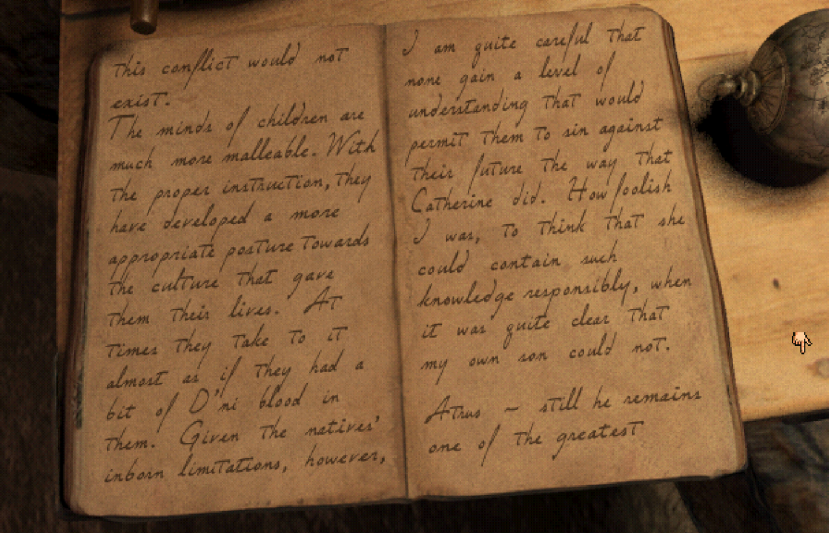
There are many examples of how Riven’s storytelling and gameplay are interwoven, but I’m going to focus on one: the number learning toy.
In Riven there is a fictional culture called the D’ni. It has its own writing system and its own numeral system.
So, how do you learn to read D’ni numbers (which is necessary to solve many of the puzzles in Riven)?
If this was Myst there probably would just be a chart somewhere with D’ni numerals in one column and Arabic numerals in the other column. This would have been lazy on the part of the developers, and boring for the players.
Luckily, Cyan’s dedication to their new design philosophy made sure that learning moments like these were dynamic, immersive, and engaging.
You learn to read the numbers by going to school. Literally.
Near the Rivenese village there is a schoolhouse where the children go to learn their D’ni reading and writing. In the school there is a toy that the children can play with (the visual/mechanical design of the toy is actually rather creative, but I’m not going to get into that).
How the puzzle works:

There are two wooden men, each hanging from a gallows. Below them is a wooden whale, waiting to eat them. You flip a switch, the whale switches sides, a random symbol pops up, and then one of the men drops down several clicks.
The men take turns dropping down until the first one to reach the bottom gets eaten by the whale. And then the game restarts.

And that’s it.
(Here’s a youtube walkthrough of the puzzle.)
What the player has to figure out (spoilers) is that the number of clicks the wooden man drops is related to the symbol that pops up on the toy. So, if a wooden man drops down three clicks then the symbol that is showing represents the number 3.
(Sidenote: The player’s work isn’t done when he maps each symbol to a number. The toy only has symbols from one to ten, but he needs to learn the symbols as high as twenty five. So, with these first ten symbols the player has to notice that there is a mechanism in the numeral system for generating more numbers, which is that (spoilers again) low numbers can be rotated to create higher numbers, and low numbers and high numbers can be overlayed to create even higher numbers. If you take the symbol for 1 and rotate it 90° you get 5; and if you take 5 and superimpose it on 1 you get 6, and so on. Basically, even the numeral system itself is a visual, mechanical puzzle, which is absolutely genius and brilliant, and I could write a whole blog post on that, but I won’t.)
Some clever things about this puzzle:
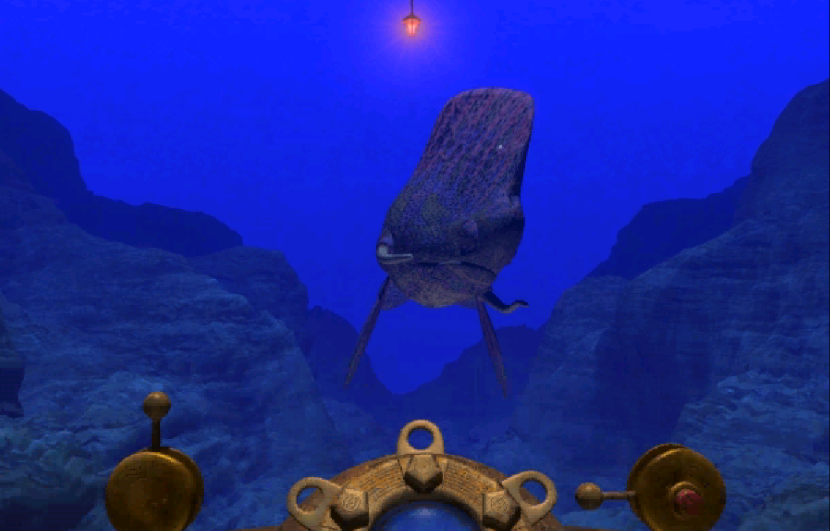
The first clever thing about this puzzle is its design. As I’ve said, those clues could be given through some static chart, but instead they’re provided in an interactive and engaging way.
The second clever thing is that the puzzle’s existence make sense in the reality of the game’s narrative. The puzzle serves a purpose to the people in the world of Riven. It was created for a purpose. It’s not just a riddle blocking the player’s progress. Which is very unlike Myst’s artistic, abstract puzzles that were divorced from the narrative completely.
The third clever thing about this puzzle is that you learn something about the world. You learn about the characters and the story, not through a dialogue tree or cutscene or flavor text, but by walking in the footsteps of the characters and simply interacting with their world.
The world of Riven is ruled by a D’ni tyrant, named Gehn, who wants to replace the Rivenese culture with that of his own. Dissenters are executed by being fed to a carnivorous whale that the tyrant keeps as a pet (the carnivorous whale is a symbol used by Gehn throughout the world of Riven). You learn some of these narrative elements in this puzzle and then they’re reinforced in other parts of the game as well.
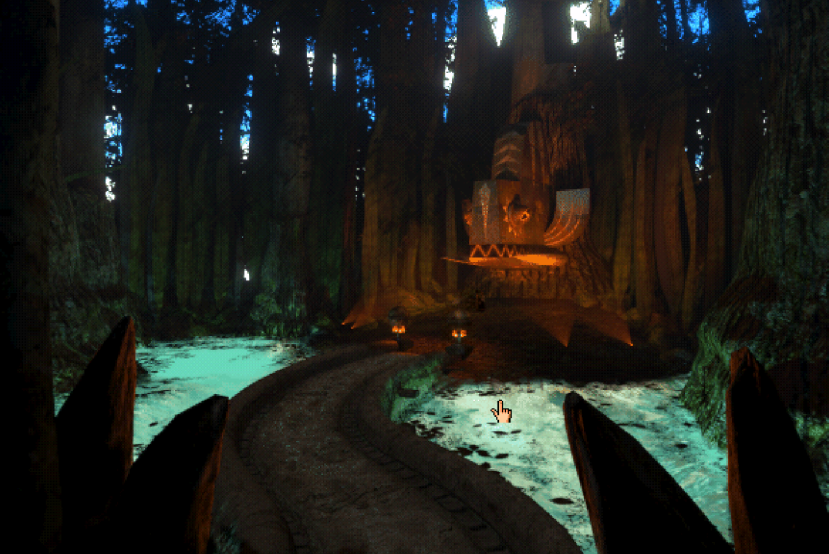
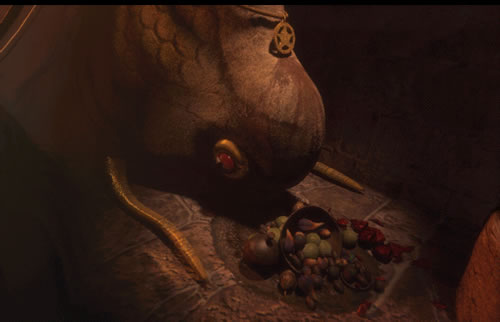
The way the children of Riven are taught D’ni numbers is a reminder of the power that Gehn wields over them and their familes. Children are taught numbers by casually being threatened with execution. That tells you something about Gehn as a character. It tells you something about the lives of the Rivenese people. It tells you something about the world you’re in. And it tells you how to read the D’ni numerals which you need to solve other puzzles.
The stunning conclusion:
By playing with the number toy you are not only engaged in solving a puzzle which gives you clues to more puzzles, but you’re also learning about the world, its history, and its people. The two experiences cannot be separated. Puzzle solving and storytelling are the same experience.
And that’s what’s ultimately so brilliant about the game design in Riven: The way the player solves the puzzle is the narrative. It’s the players’ realization of what to do that tells them a story.
This aspect of fusing gameplay and narrative is riddled throughout the game of Riven, even for things that aren’t puzzles.
A couple more quick examples:
The way to get to the schoolhouse is across a lake. According to “From Myst to Riven” the way to do this originally was going to be a sailboat. But the developers realized that the tyrant, Gehn, would never entrust anything to something as fickle and frivolous as wind power. So, instead, you get across the lake through a submerged, metal submarine that can only move along rails like a train car. Power, control, isolation: these are the characteristics of Gehn represented by this one vehicle.
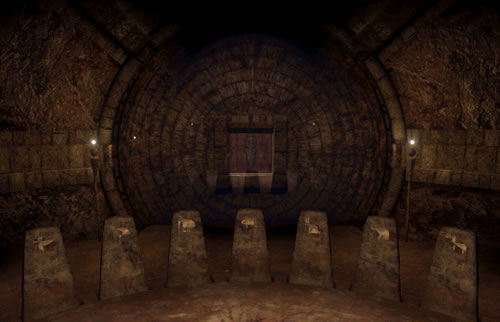
There are rebels who fight against Gehn in Riven. To get to their secret hideout you have to enter a specific set of animal symbols. So, sure, their reliance on natural imagery separates them from Gehn’s mechanical, industrial style. More interestingly is that you have to enter five animal symbols to access the hideout. This is significant because the number five is sacred to Gehn and his D’ni culture, and it appears throughout the game. But what this means in this one puzzle is that even though the Rivenese rebels are fighting against Gehn, their world has been permanently altered by his presence. The D’ni culture has changed the mindset of the Rivenese people, whether they like it or not, and that’s why the number of symbols in their code is a number sacred to their oppressor. And that’s a story told in just the number of symbols you enter to unlock a door.
The equivalent of all this in, let’s say, an action game, would be if the way to kill an enemy told you something about them as a character. The realization of why the enemy has to be killed in a certain way tells a story about the world you’re in. I suppose there might be a few examples of this here and there in action games, but there’s definitely not that many, nor any that permeate throughout the entire game the way Riven’s ludo-narrative fusion permeates throughout itself.
I should have some clever concluding sentence, but, meh, whatever, blogpost over. Hope you liked it.
(For more insights into Riven’s design, check out this post by Jeroen D Stout, where he takes a look at Riven from an interesting perspective, and also makes some comparisons between its storytelling techniques and those of modern walking-sims like Gone Home, Dear Esther, and Firewatch.)
Very well written. I LOVED Riven and enjoy replaying it every 5 years. :-) You make a very good point about Mr.Vander Wende’s approach to this game and now I want to find out more about HIM! Thank you for this blog. It was Rivenetting!
LikeLike
Thank you. I’m glad you liked the post.
LikeLike